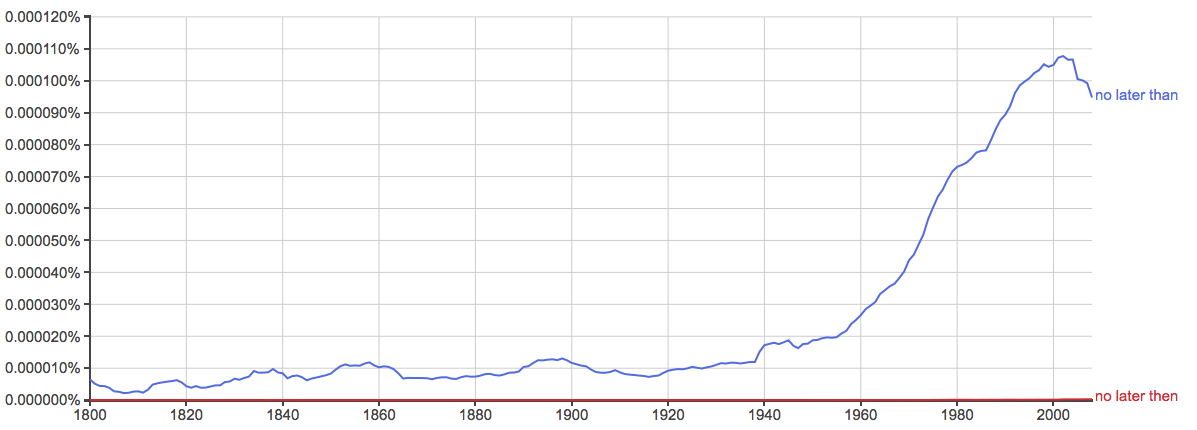Homophones are words that sound the same but have different meanings. English has many homophones, and most of them are confusing.
Than and then are two such homophones. Each of these words has been in English for many centuries, and they have confused writers for just as long.
For all of the confusion that arises with these two words, they are actually different parts of speech—than is a conjunction and a preposition, while then is an adverb.
Since the words mean different things, they cannot be used interchangeably, and you will need to know the difference between them, especially in phrases like no later than or then, only one of which is correct.
What is the Difference Between No Later Than and No Later Then?
In this post, I will compare no later then vs. no later than. I will outline the correct spelling of the phrase, and I will show you a memory tool that helps when you need to choose no later then or no later than for your writing.
When to Use No Later Than
 What does no later than mean? No later than is an adverb phrase. It specifies the outer limit of when something can occur.
What does no later than mean? No later than is an adverb phrase. It specifies the outer limit of when something can occur.
People should arrive for work no later than the beginning of their shifts. You should also renew your car’s registration no later than your birthday.
Here are a few more examples,
- Please RVSP for the wedding and the reception by no later than August 15, 2017.
- The pizza will be ready by no later than 5:35, so we should leave at 5:20 to make sure we get there while it is still hot.
- Closer Zach Britton will rejoin the Orioles on Monday in Boston and be reinstated from the disabled list no later than Tuesday, manager Buck Showalter said after Sunday’s 7-4 extra-inning win over the New York Yankees. –The Baltimore Sun
When to Use No Later Then
 What does no later then mean? No later then is a misinterpretation of no later than, based on the homophones than and then. Than is a conjunction that works as part of comparative phrases, but then is an adverb that specifies time, so no later than and no later then don’t mean the same thing.
What does no later then mean? No later then is a misinterpretation of no later than, based on the homophones than and then. Than is a conjunction that works as part of comparative phrases, but then is an adverb that specifies time, so no later than and no later then don’t mean the same thing.
It’s understandable that writers would confuse than and then in this phrase, since it deals with a point in time. Still, no later than is the only correct version of this phrase. The chart below provides visual evidence.

This data isn’t 100 percent exhaustive in its scope, since it only looks at books published in English since 1800, but it still shows that no later than is almost universally accepted as the standard version of this phrase.
Trick to Remember the Difference
You should only ever use no later than in this phrase. While no later then might seem to make a certain kind of sense, it is not a standard variant.
Since no later then contains an extra E, you will find it easy to remember that no later then is an error, and has no place in formal English.
Summary
Is it no later than or then? No later than is an adverb phrase that specifies a time at which something will happen. No later then is a mistake based on the homophones than and then.
To summarize,
- Use no later than.
- No later then is an error.
Contents
